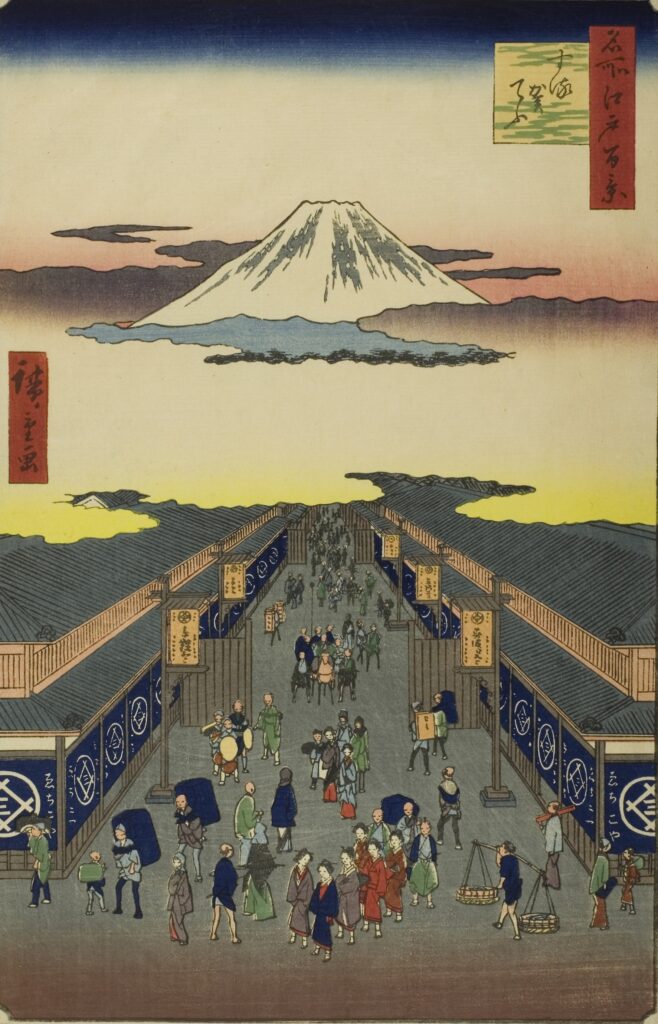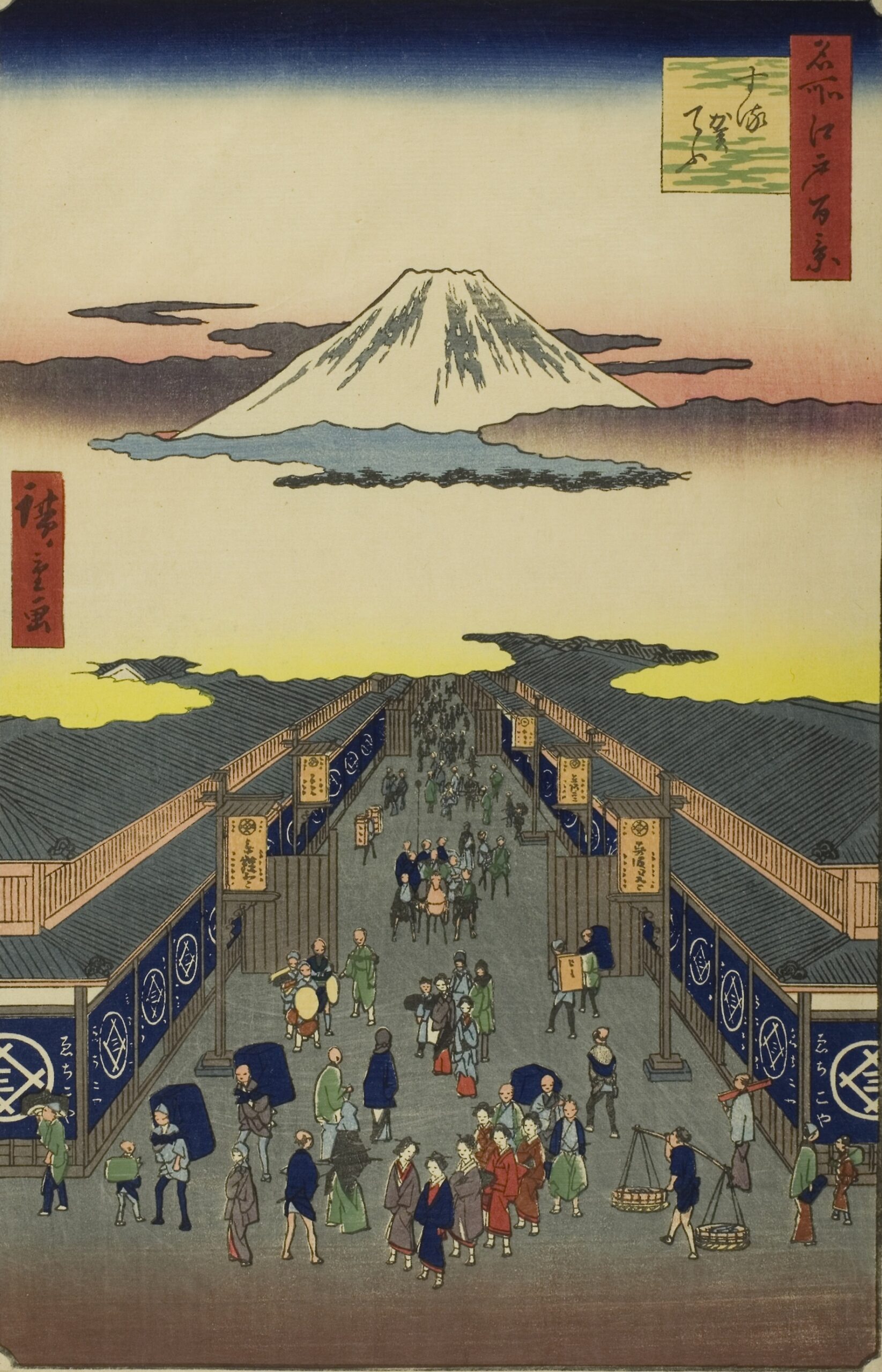
Utagawa Hiroshige – One Hundred Famous Views of Edo – 8 – Spring – Suruga Tefu 歌川広重-名所江戸百景-8-春-する賀てふ 解説
Current Address: Near Muromachi 1-2, Nihonbashi, Chuo Ward
Latitude and Longitude: Latitude 35.6864, Longitude 139.7727
Published: September 1856 Age: 60
Commentary
<1> Introduction
“Suruga Tefu” is a striking composition, showcasing the sacred Mount Fuji over the streets of Edo Castle.
This painting simultaneously captures the urban space of Edo and Mount Fuji, a symbol of nature.
This painting can truly be described as a “landscape painting unique to Edo.”
The ingenious composition, the historical background of the depicted townscape, and the widespread culture of viewing Mount Fuji are evident.
This work demonstrates how beloved it was among the common people of Edo.
<2> What is “Suruga Tefu”?
“Surugacho” is the name of a neighborhood in what is now the Muromachi area of Nihonbashi in Chuo Ward.
It was named after merchants from Suruga Province (Shizuoka Prefecture) who lived there.
During the Edo period, Surugacho was the central commercial district of the Nihonbashi area.
Dried goods stores and wealthy merchants lined the streets.
In particular, it was here that Mitsui Echigoya (now Mitsukoshi Main Store) opened.
From the streets of Surugacho, Mount Fuji could be seen directly ahead.
For the townspeople of Edo, being able to see Mount Fuji in their everyday scenery was a special source of pride.
Echigoya was a store that sold kimonos, and was founded by Mitsui Hachirōemon Takatoshi, a native of Ise, who came to Edo and opened a kimono store.
The name Surugacho itself comes from Suruga, where Mount Fuji is located.
The store initially opened in Honmachi, where there were many kimono stores, and made a profit by offering cash-on-delivery services with no markup. He amassed wealth within a few years, but perhaps due to harassment from fellow merchants, he moved to Surugacho when Honmachi was destroyed in the Great Fire of Edo.
<3> Highlights of the Painting
Mount White Fuji, towering large in the distance, is placed majestically at the front of the street.
Mount Fuji’s beautiful triangular shape was a symbol of good fortune for the common people of Edo.
The painting depicts a thriving commercial district, with the eaves of large stores lined up in neat rows on both sides of the street.
The bustling commerce is conveyed by the curtains and signs hanging from the eaves.
The linear perspective extending down the street naturally draws the eye to Mount Fuji.
This is a skillful composition that integrates the Edo townscape with Mount Fuji.
Depicting people visiting the shops and laborers carrying loads, the bustle of the commercial district is realistically portrayed.
The everyday movements of people add a sense of dynamism to the landscape.
Echigoya stores are located on both sides of the road.
<4> Mount Fuji for the Common People of Edo
Mount Fuji was the center of Asama faith and a sacred presence for the common people of Edo.
Even viewing it from afar was considered miraculous.
Places from which to view Mount Fuji, such as Fujimizaka, were popular in Edo.
Suruga-tefu was one such spot, where townspeople would gaze up at the mountain in between shopping and work.
Mount Fuji is considered an auspicious mountain, representing longevity and prosperity, and is often depicted as a “celebratory landscape” in ukiyo-e prints.
<5> Walking through Modern-Day Surugacho
Mitsukoshi Nihonbashi Main Store still stands in the center of the street depicted in the painting.
Experience the history of Japan’s oldest department store, which dates back to the Echigoya Kimono Store in the Edo period.
The Surugacho area remains one of Tokyo’s most representative commercial districts.
There are buildings and monuments that evoke the atmosphere of the Edo period.
Unfortunately, today’s streets are lined with skyscrapers, making it impossible to see Mount Fuji from the streets.
However, by learning about the history of this “Fujimi Town,” you can imagine what people back then must have felt.
<6> Tourist Guide
1. Stroll the Streets with a Hiroshige Ukiyo-e Print
Walking through Nihonbashi Honcho while looking at “Suruga Tefu” (Suruga Tefu) allows you to imagine what the streets looked like during the Edo period.
2. Explore the History of Mitsukoshi Nihonbashi Main Store
Visiting Mitsukoshi, the birthplace of Echigoya, will give you a sense of the changing commercial culture.
3. Learn About the Relationship Between Edo and Mount Fuji
Touring the historical exhibits and museums in the Nihonbashi area will deepen your understanding by learning about the Edo commoners’ worship of Mount Fuji.
4. Find Place Names Representing Fuji Viewing
Places such as “Fujimizaka” (Fujimizaka) and “Fujimi-cho” (Fujimi-cho) remain in Tokyo to this day.
You can trace the sensibilities of Edo people who admired Mount Fuji.


内八ツ小路-120x68.jpg)